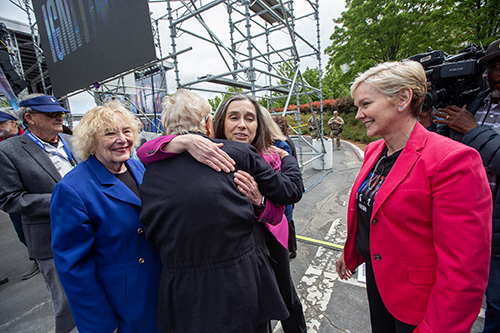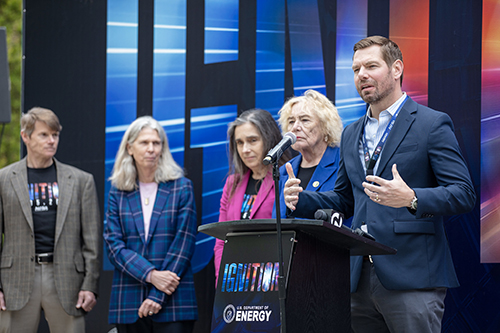Igniting the future: Hundreds gather to celebrate historic fusion achievement
 (Download Image)
(Download Image)
Department of Energy (DOE) and National Nuclear Security Administration (NNSA) officials, members of Congress, past Lawrence Livermore National Laboratory (LLNL) directors, employees and partners gathered on May 8 to celebrate the Lab’s 2022 fusion ignition achievement. Pictured are (l-r) NNSA Livermore Field Office Manager Janis Parenti, NNSA Deputy Administrator for Defense Programs Marvin “Marv” Adams, DOE Secretary Jennifer Granholm, DOE Under Secretary for Nuclear Security and NNSA Administrator Jill Hruby, LLNL Director Kim Budil and U.S. Rep. Zoe Lofgren. Photo by Blaise Douros.
On a day certain to rank in the upper echelon of Lawrence Livermore National Laboratory’s historical milestones, Department of Energy (DOE) and National Nuclear Security Administration (NNSA) officials, members of Congress, past Lab directors, employees and partners gathered on May 8 to celebrate the Lab’s 2022 fusion ignition achievement.
Even a light shower couldn’t dampen the enthusiasm for the celebration, as the hundreds in attendance honored the researchers, stakeholders and supporters that made the successful Dec. 5, 2022 shot possible. On that date, scientists conducted an experiment at the National Ignition Facility (NIF) that produced more energy from a fusion reaction than the laser energy required to create it, otherwise known as ignition — a historic first.
More than five months removed from the earth-shaking result, distinguished speakers at the celebration lauded the achievement as a “remarkable breakthrough” for stockpile stewardship and national security, and the start of what officials said they hope will open the floodgates to developing fusion as a viable, carbon-free energy source.
With NIF serving as a backdrop for the speakers’ on-stage remarks, LLNL Director Kim Budil, the event’s emcee, welcomed the throngs in the audience and the many more employees watching online to an “extraordinary class reunion” of fusion’s luminaries, sponsors and supporters. DOE Secretary Jennifer Granholm called fusion the “holy grail” of clean energy, and honored the countless scientists, researchers target fabrication experts and operations teams who contributed to ignition over the past 60-plus years, including fusion pioneer and former Lab director John Nuckolls, who was in attendance for the event.
Past Lab directors and fusion science luminaries were among the guests of honor in attendance for LLNL’s celebration on May 8. Photo by Jason Laurea.“Today isn't just a celebration of what we've achieved with ignition; it's a declaration of all that still to come,” Granholm said. “Thank you all for joining us, for all the tireless work that I know you put into getting us into this exciting moment, and for all the invaluable contributions I know you'll be making in the months and the years ahead, because once you have harnessed the power of the stars, I imagine there is no limit to how bright we can shine.”
Granholm, who stressed the importance of public-private partnerships with industry to developing commercial fusion energy, capitalized on the moment to announce a new Inertial Fusion Energy Science & Technology Accelerated Research (IFE-STAR) funding opportunity of up to $45 million from DOE’s Office of Science. The funding — up to $9 million in Fiscal Year 2023 for projects of up to four years in length — will support creation of innovation hubs combining expertise from DOE national laboratories, academia and industry to advance inertial fusion research.
“You can already see the impact [fusion energy investment] is making on the surrounding community and the potential it has to create new jobs and grow the economy,” Granholm said. “Folks are traveling down that magnetic [fusion] pathway, but we don't have to worry about a road not taken. Thanks to this ignition achievement, we can, and we will see what both pathways hold … We believe that public-private partnerships will be key to getting inertial fusion to that next level.”
Even a light shower couldn’t dampen attendees’ enthusiasm, as hundreds gathered to honor fusion energy pioneers, researchers, stakeholders and supporters that made the Dec. 5, 2022 ignition achievement possible. Photo by Blaise Douros.Following Granholm’s comments, DOE Under Secretary for Nuclear Security and NNSA Administrator Jill Hruby thanked the “thousands of employees and partners who've dedicated their careers to making this achievement possible.” Hruby said ignition has opened new chapters in NNSA’s science-based Stockpile Stewardship Program and heralds a key step toward “unlocking the potential for a clean energy source that could revolutionize the world.”
“Reaching ignition in a controlled fusion experiment was an achievement that took six decades to realize, from the notional idea discussed here just after the invention of the laser, and involved development, engineering, experimentation and partnerships. It also confirmed something important — that the U.S. still leads big science and knows how to turn ideas into reality,” Hruby said. “It has given us so much hope for the future.”
Lab Director Kim Budil embraces former Lab Director and inertial confinement fusion pioneer John Nuckolls as U.S. Rep. Zoe Lofgren (left) and Department of Energy Secretary Jennifer Granholm look on. Photo by Jason Laurea.NNSA Deputy Administrator for Defense Programs Marvin “Marv” Adams followed Hruby by explaining the extreme difficulty of ignition from a technical standpoint, and the “nearly perfect” precision required to achieve it — from the laser power to the thickness of the target capsule surface and the materials used in the reaction. Adams praised Lab computer scientists, diagnostic teams and designers for overcoming the array of challenges to accomplish the “remarkable” feat, adding that it will lead to new experimental regimes in stockpile stewardship and help the U.S. further avoid a return to underground nuclear testing, while supporting nonproliferation efforts.
“It’s very important for our national security,” Adams said. “The achievement we celebrate today illustrates that big, important accomplishments often take longer and require more effort than originally predicted, but that big, important accomplishments are often more than worth that time and effort.”
In her remarks, LLNL Director Budil acknowledged generations of Lab researchers, as well as previous directors, collaborators and the broader fusion community for their 60 years of effort to advance national security and making “this extraordinary moment a reality.” Budil closed by calling ignition a “testament to the importance of long-term public investment in science” — a pursuit that has opened new frontiers in high energy density science and exploration of the most extreme states of matter in the universe.
In her remarks, LLNL Director Kim Budil acknowledged generations of Lab researchers, previous Lab directors, collaborators and the broader fusion community for their 60 years of effort to advance fusion research and national security, and for making “this extraordinary moment a reality.” Photo by Jason Laurea.“With the achievement of ignition, we've opened a new era of national security applications using high fusion yields and demonstrated the fundamental building block for an inertial fusion energy source — truly a game-changing technology,” Budil said. “Today is not the end of the journey; it marks the beginning of what will be an incredible era of discovery and innovation.”
U.S. Rep. Zoe Lofgren (D-CA18), a longtime supporter of NIF, recalled past battles for funding of fusion ignition experiments dating back to the 1990s. Lofgren stressed the value of supporting ongoing fusion research as a potential clean energy source to help combat climate change, and said the Lab’s achievement has ignited support in the U.S. Congress to appropriate additional funding for fusion as recommended by the Fusion Energy Sciences Advisory Committee (FESAC).
“Now is the time to move aggressively towards the deployment of fusion energy,” Lofgren said. “We are so used to people who scoff at that concept, but we all know because of your efforts, we're closer than ever.”
Following the ceremony, the speakers were joined by U.S. Rep. Eric Swalwell (right) to participate in a press conference, where they discussed the next steps in fusion research and the path for commercial fusion energy. Photo by Jason Laurea.After the ceremony, the speakers were joined by U.S. Rep. Eric Swalwell (D-CA14) and participated in a press conference, where they discussed the next steps in fusion research and the path for commercial fusion energy.
“We are always trying to achieve energy that is clean and abundant and reliable,” Granholm told reporters. “If you can replicate the process that's on the sun, you provide abundant renewable energy; that's really what fusion is. We're not there yet. People who are excited about clean energy should be really excited about the discovery here, because it means that that holy grail of 100-percent clean energy, that doesn't provide any waste, is possible.”
LLNL’s Budil said the future could include upgrades to NIF, and more collaborations with private companies to improve the target fabrication processes, along with further increases to NIF’s energy output to aid in reproducing ignition on a regular basis.
“What we're embarking on now is a refurbishment of many of the components of the lasers that have been operating at full tilt for more than a decade, and many of its subsystems need some significant maintenance,” Budil said. “It’s going to be an exciting few years, and we think this facility has the potential to produce more laser energy. And as we've shown, a little bit of energy goes a long way in these experiments.”
Budil added that while the Lab has yet to replicate the groundbreaking Dec. 2022 experiment so far in 2023, LLNL is continuing to produce new targets and is working to perfect the process for future experiments with conditions that more closely resemble the ignition shot.
Several hundred employees from across the Laboratory viewed the festivities either in-person or virtually online. John Ruiz, a mechanical designer in the Laser Systems Engineering and Operations Division supporting NIF, and a Lab employee since 2016, said he had to see history made for himself.
“I wanted to come out and celebrate with everybody else,” Ruiz said. “We’re very proud to be a part of this whole endeavor. It feels really great to know that we’re being recognized for all the hard work we put in.”
Florinda Santos, a custodian at LLNL, said she felt “blessed” to be able to personally take part in a momentous milestone, both for the Lab and for the entire world.
“The new future that's going to be coming up for us is going to be really challenging and really good,” Santos said. “It’s going to be exciting to see what comes forth after this. It’s just awesome to be part of this event and be here with everybody today.”
Sarah Kennedy, an office manager in the Weapons and Complex Integration directorate, added: “This is just such a huge deal, and it's such an exciting thing for the Lab and for our country, so I wanted to be a part of it. It’s incredible what they've been able to accomplish; this once-in a lifetime thing. It’s really neat to see that they're celebrating it as much as it deserves to be celebrated.”
As the skies cleared, fittingly revealing a brilliant warm sun peeking through the clouds, many Lab employees enjoyed special “ignition-edition” cookies strategically placed at stations across the Lab.
Clad in his commemorative ignition T-shirt while sampling each of the cookie flavors at the Central Café, Tim Cunningham, who works in the NIF Target Diagnostics Factory, called the ignition celebration “incredible.”
“It was amazing, I loved it, it was good to be part of it,” Cunningham said. “Just to hear what the Secretary of Energy and the head of the NNSA said about this — the accolades, it was amazing. I enjoyed it.”
Cunningham said his whole team, which builds and processes the data from the diagnostics used at NIF, sat together at the ceremony to listen to the speeches. “How many jobs can you go to where they’ve been trying something for 60 years and we just proved it? Not many.”
Nick Lewis, who was noshing on a honey-orange cookie, joined the Lab five months ago as ignition was being achieved. Lewis said “it was just starting to get more interesting” as he was beginning his Lab career, and that “this celebration is pretty awesome. Very clearly, there’s a new steppingstone to bigger and bigger things. And that’s exciting.”
Randy Strauser, lead technician in Target Fabrication, has worked for General Atomics for 23 years, the last 13 of them at LLNL, and was pleased with the event.
“The Lab is really good at doing a celebration of milestones,” he said, adding that this was the one “everybody’s been waiting for.”
“I didn’t want to retire until they got ignition,” Strauser said. “It’s history in the making and now it's going to be exciting to see what's going to go on next.”
The celebration is available to view here. A photo gallery of the event is available to view here.
Benny Evangelista contributed to this report.
Contact
 Jeremy Thomas
Jeremy Thomas
[email protected]
(925) 422-5539
Related Links
Department of EnergyNational Nuclear Security Administration
Tags
Lasers and Optical S&TLasers
National Ignition Facility and Photon Science
Community Outreach
Featured Articles












